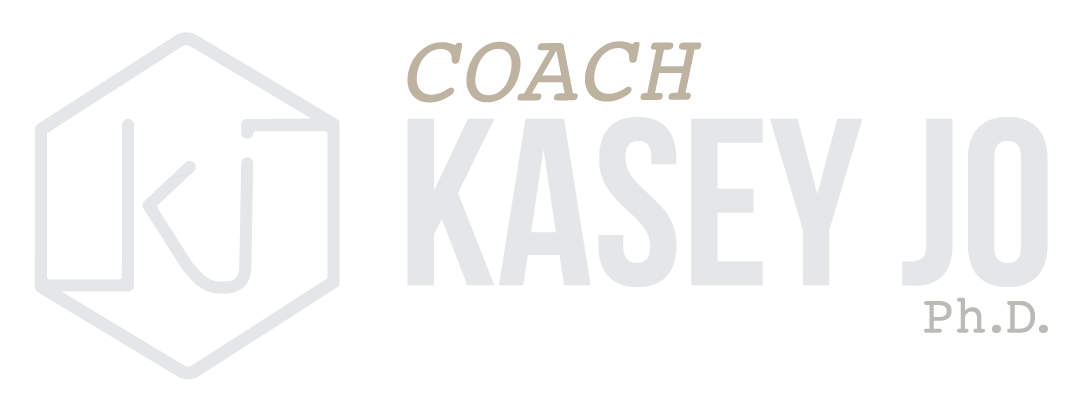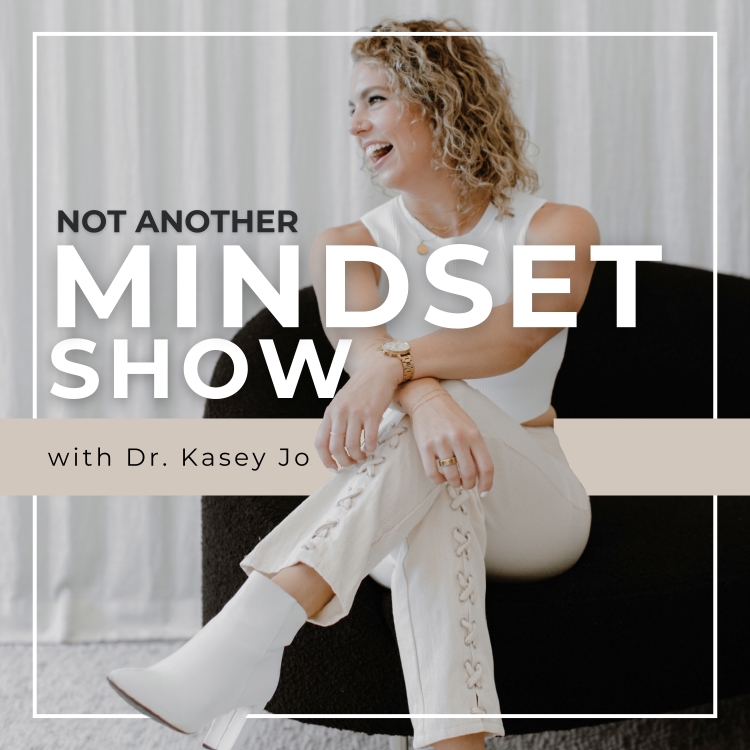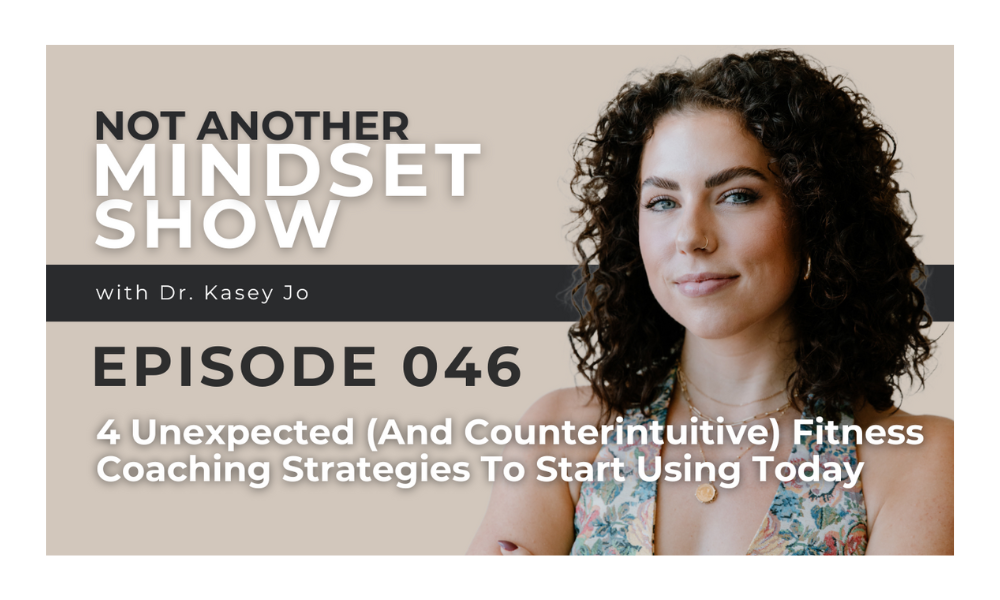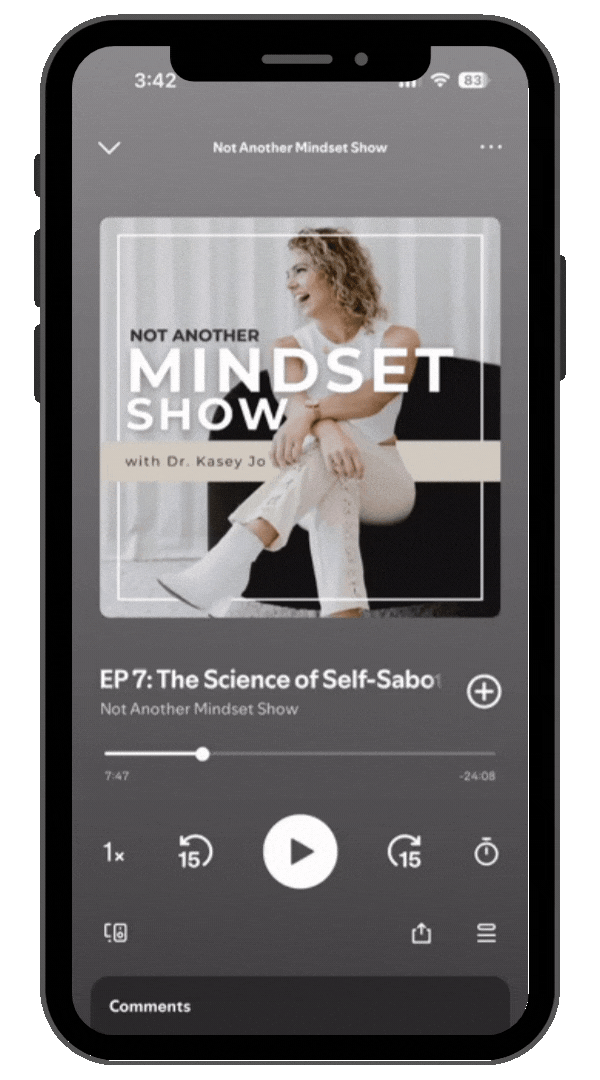Sometimes the strategies that help your clients achieve their goals are the ones you would least expect to try.
If you feel like you always have some clients that just keep self-sabotaging and can’t stick to the plan, no matter what you try, you’ll want to get your hands on my 5 FREE lessons in behavior change and mindset. These lessons will help you coach your clients to overcome all-or-nothing thinking and fixed mindsets, stop getting in their own way, develop more self-control, and increase motivation and follow-through.
In this episode, I’m sharing easy fitness coaching strategies you can implement in your coaching practice today.
I share four counterintuitive coaching strategies that can help clients make significant progress. These coaching tools help foster client autonomy and cultivate long-term behavior change, which leads to happier, more successful clients!
Episode Highlights
>>(2:21) Ask your coaching clients what they would do if they were fitness professionals.
>>(6:08) The importance of asking your clients open-ended questions about your client’s life outside of fitness.
>>(8:40) Ask what good things come from their current unhealthy behaviors.
>>(11:31) Ask your clients permission to provide suggestions and recommendations.
Listen to the full episode to find out why each of these things will improve your coaching practice and how to properly implement them to help your clients achieve their goals.
Rate, review, and subscribe to my podcast.
If you enjoyed this episode, I’d be incredibly grateful if you could rate and review the show on your favorite platform. Your feedback helps me improve and allows others to discover the show. I want to hear from you whether you’re loving the insights or have suggestions on how I can make the show even better!
Simply scroll down to the review section on Apple Podcasts, Spotify, or wherever you listen, and leave your thoughts. Your support means the world to me and helps me continue to bring you more of the content you enjoy.
Links From the Podcast
Listen to Episode 39: The Coaching Framework for the MOST Effective Results: The GROW Model
Want me to answer your questions on my next Q&A episode? Drop your questions here!
Health Mindset Coaching Certification Instagram
Getting started with the Health Mindset Coaching Certification (5 FREE lessons included!)
Episode’s Full Transcript
Hello my friends, and welcome back to not another Mindset show. I’m your host, Dr. Kasey Jo. My goal with this podcast is to take the science of mindset and behavior change and distill it down into actionable takeaways for you. Together we’re gonna unpack research around motivations, self-sabotage, willpower, and so much more, and we’re going to take all of that and translate it into strategies you can immediately apply.
To your health, fitness, relationships, business, marketing clients, all of the things. But just to be clear, it’s not all serious and sciencey around here. We’re gonna have a ton of fun too, and I’m so excited to share all of this with you. All right, let’s go ahead and get into the episode. Hello my friends.
Welcome back to not another mindset show. Today I have what I’m calling like a, a rapid fire, quick fire type of episode. Hopefully it will, it will go that direction. ’cause we know I can be, I can be a little wordy, however, I know we love the ability to just like take a strategy or take a question and bring it immediately back to our clients and.
Most of my episodes have a lot of context. They have a lot of background. I want you to understand why humans do what they do, how our brains work, so you can really understand the psychology of your clients, what’s going on in your own brain, rather than just plugging and play, plugging and playing with like specific.
Little strategies and tips and hacks and what have you. But today I do want to give you just four quick tools that you can use with your clients, and they’re counterintuitive tools, meaning. I’m going to say them and you’re going to maybe question how that’s going to work. Um, I’ve mentioned some of these tools in previous episodes, specifically when I’ve talked about the Grow Model, which is my effective framework for coaching.
G is for guidance, R is for relationship. O is for. Optimization and W is for wisdom. So I’ve talked about this framework before and I’ve talked about these tools in some contexts, but I want to give you, like I said, just quick fire tools based on that framework that you can use with your clients. So tool number one, ask your clients what they would do if they were the coach.
And this is counterintuitive because obviously you are the coach and your clients are expecting you to coach them. They didn’t hire you so that they could coach themselves. I know. However, one thing that is so incredibly important that we do with our clients, look at me giving you more context and background after I said I wasn’t gonna do a lot of that, but there needs to be a little bit, okay?
One thing we really need to be striving to do. Is cultivating autonomy in our clients and helping them get to a place where they feel like they can make their own decisions and they know what to do next. They know what’s best for themselves, so eventually you don’t have to coach them anymore. That is really the goal, right?
That they feel confident doing some of this stuff on their own, and it also makes your life a lot easier while they are still working with you because you’re not having to do. So much handholding and taking them through the step by step of every single little process. And instead they come to you and say, Hey, I think I wanna try this, or, Hey, I think I’m gonna do it this way, or I have this goal for the week and this is how I’m gonna do it.
And you can kind of sign off on it or provide some feedback, but they get to be in the driver’s seat. And this tool, asking your clients what they would do if they were the coach, can really be helpful from that autonomy supportive standpoint. And I would not recommend doing this all of the time, right?
Uh, anyone would get pretty annoyed if, if you went to them and just said, well, what would you do in this situation? Even though maybe they’re asking you for advice, right? Um, so I would use this. If you are working with someone who is really struggling to adhere, stick to the plan. Maybe you’ve tried a handful of different things and they’re not working, and both of you are kind of at this sticking point, so you can go to them and ask them this question.
If you were the coach. This position and you’re coaching yourself, or if I was the client, what would you say to me in this situation? And you know, you might get some pushback. They might say, well, I don’t know. I’m not the coach. Like that’s why I have you, and you can play with this, right? You can say, humor me for a second, if you are in my position as the coach, what do you think you would say to you?
Or what would you say to a client? This actually could be good if you take it. That step further and say, if you were a coach and you were working with someone else who was struggling with this, what would you do? What would you say to that person? And you can frame it as like a thought, exercise and mindset, exercise, whatever you need to do in order for them to, to see the, the utility and the value in this question, actually, like removing it from even your coaching relationship and saying like, if you were a coach, what would you tell a client or what.
Thoughts, suggestions, ideas, would you have for them? Because if we can remove. Ourselves as the coach and the client in this relationship and have them kind of like think about it and zoom out a little bit more. They can potentially detach from their situation and any like emotions and stuff that comes up with that and see it a little bit more objectively.
So again, counterintuitive because you are the coach. So why would we ask our clients to do the coaching? Right? But it can be so helpful and provide a lot of insight for you. As the coach and for them, I’ve used this tool so many times over the course of my coaching career and every single time something is uncovered that is really helpful and helps guide me in my decision of like, what should we do next with this client?
Okay, tool number two, ask open-ended, and that’s the important part here. Well, I mean it’s all important, but open-ended questions. About your client’s life outside of exercise and nutrition. And I, I know that sounds like a little bit like duh, like you need to build a relationship with your clients and you need to like care about them beyond their step count.
But it can feel counterintuitive because like why are we spending time. A precious time when maybe you have 50 clients on your roster to be asking questions about how that promotion is going, that they’re working towards at work. But this is so important from a relationship building perspective, and I think we’ve all been there where we’ve worked with people who have had coaches in the past, and they’ve made comments about how the coach that they worked with in the past.
Had a ton of knowledge, knew what they were doing. Maybe they saw results with that person, but they just didn’t feel connected with them. So it can get hard when you do have a full roster of clients and you’ve got a whole other life outside of coaching to really do your do, do what are words really do your due diligence.
Say that 10 times fast. Um, clearly I can’t even say it once, but. Do your due diligence. I need to stop saying it to really make it a point to make it clear to your clients that you care about them outside of if they hit their protein this week or if they got their water intake right, so you can systematize this and it can go into like their client check-in responses.
Something I used to do is like when I knew my clients were going through something or there was something else going on outside of the nutrition and fitness context, I would literally add questions to their individual check-in forms that was like, Hey, I wanna hear about that thing that’s going on with you this week.
And you’d have to like rotate out that question, right? Or you could like just leave it in your check-in at the end. Like, Hey, I also, in addition to all of this, really wanna know what’s going on. Like, I know you mentioned that you’re having. Some hard times in your, in your marriage, but you’ve been working on it.
Like, I haven’t heard about that in a little while. Like, tell me more. Um, it can be so helpful, again from a relationship building standpoint, because ultimately people hire people and they wanna work with people. Otherwise they would just go to chat GPT to get their macros, right? So that’s tool number two.
Tool number three, ask clients about the good things that come from their unhealthy behaviors. Clearly this is counterintuitive because why the heck would we want our clients to double down on all of the good things that come from the unhealthy behaviors that they’re trying to get rid of? Like, that seems silly, like why would we wanna remind them of those things?
But it’s not silly. It’s not silly. That’s why we’re talking about it. If we can do this and the client comes back and says, well, here’s all the reasons why. Eating fast food multiple times per week is doing good things for me. It’s saving me time. It allows me to spend more time with my family. It’s, it takes something off my plate, my mental load.
I don’t have to think I can just go home after work instead of having to cook and like think about a healthy meal and all of this stuff. So what’s beautiful about this is oftentimes, and I would say more often than not, when you ask this question, obviously your clients are already looking at. Changing their behaviors and likely getting rid of some of these behaviors that you’re talking about, these unhealthy behaviors that are not supportive of their goals, right?
They’re already in that headspace, but bringing them back to the good things that come from the unhealthy behaviors really makes them reflect for a second. And like I said, more often than not, and this is typically the case, they will share all of those good things and then back it up with some change talk.
They’ll say things like. Yes, it saves me time and it does all these great things for me, but I know there’s different ways to go about this, but I know I could be including my family in the cooking process when I get home, and that could be really beneficial for them in a lot of ways, rather than me just like showing up with McDonald’s at the end of the day.
So what’s great there is that you can then take that part and expand upon it and ask them more about what that would look like. Like do you think that that’s something you’re really capable of doing? Is that something we could start to play around with? Like, how do you think we could take all of these good things from these unhealthy behaviors and keep the good things?
Start doing something healthier and just like get their gears turning in that direction and trying to pull out the good stuff and still include those good things. Because here’s the thing, the reason that they are doing those unhealthy behaviors and getting these benefits, we’ll call them. That’s the reason why they can’t stop doing them because of those benefits.
If the benefits didn’t exist, they wouldn’t do the behavior. So if we can create those benefits in a different way, that’s actually supportive of the goals that they’re trying to achieve. Sounds like a winning scenario. Right? And that’s a really great way to, to get there. I. Okay. The final tool is to ask permission before providing suggestions or knowledge on a topic.
And this one is hard to do. This one’s hard to do, and it’s something I think that that ties back to a, a mistake, a misstep, we’ll call it. That I see with coaches all the time, and it’s immediately providing solutions, immediately telling their clients what to do when they see them struggling and it’s coming from a good place.
We wanna help these people. It’s literally why we’re in this profession, right? But if we’re constantly giving them all of the answers, then they’re not actually learning anything and we’re not building autonomy. There’s that again. So there’s some other aspects to this too, where sometimes we don’t know everything that our clients know, and our clients ultimately are.
The ones who know the most about themselves and their desires and their preferences and the knowledge that they already have. So if your client is struggling to hit their water intake and you’re just going back to them and say, Hey, I noticed that you’re struggling to hit your water intake this week.
Why don’t we try filling up your reusable water bottle? At the end of the day and setting it next to the sink in the morning. So you have it right there and ready to go. Like, I think you should try that. And then they come back to you and they’re like, I already do that. And that’s where the water that I am getting is coming from.
It’s the 32 ounces that I drink right away in the morning, and then I kind of forget about it throughout the day. So that was. Entirely unhelpful. Right? And now you’re wasting not only their time, but your time because you’re providing suggestions of things that they’re already doing and they may come back.
Also feeling a little bit like maybe it was condescending, like you think, like the, the most easy, the easiest thing I could do to solve this problem. Like obviously I’m already freaking doing that, right? So. Not saying that that’s always going to happen, but it could happen if you’re just immediately providing suggestions and solutions without asking permission.
And I’m, I’m saying ask permission because again, you don’t know what they’ve already tried, what they’ve already done, unless you do right. Then like that’s a different story, but. Instead, what you could say is, I have some ideas for you. I, I have some thoughts and some things that maybe have worked for clients in the past, but I don’t wanna make assumptions that you’re not already trying these things, or you haven’t already tried these things.
So before I get into that, can you tell me a little bit more about what you’re currently doing or what’s worked well for you in the past? So, asking permission, asking some questions, getting clarification like you’re taking the same amount of time to do that. You are to just immediately provide solutions.
So you might as well do that first. Um, again, it feels counterintuitive, just like all of these tools because they’re paying you for your ideas and your suggestions and your expertise. So going to them first and saying like, Hey, is it okay if I share these things or I would like to share some things, but let’s do this first.
Feels like you’re kind of like beating around the bush in a way. However, it’s so helpful, so helpful and like, like I said, it can, it can really, it’s like a fail safe from making assumptions that are incorrect and allows your clients to really feel like you want to hear their whole story and better understand them rather than just like handing them solutions that may or may not even like fit for themselves and their lifestyles.
So. Those are the four counterintuitive tools I have for you. I think there’s one other thing that kind of came up for me while I was talking about this, and this is still gonna be a short episode. It will be I, I promise. But for you as a coach, like a tool for yourself is. These tools can feel counterintuitive and not the way that like maybe you were traditionally taught to coach.
But here’s the thing, no one’s like teaching you really how to coach. They’re just teaching you about nutrition and exercise most of the time. Not really like the art and the skills of coaching, which is why I exist on this planet Earth is to help you do those things. But. The tool I have for you is to seek discomfort, and that’s kind of just like what came up for me while I was saying all of this is how you’ve always done things as a coach.
You have to remember like just like your clients, if you keep trying to do those things and they’re not working but you don’t wanna try something else ’cause it’s uncomfortable or it’s going to take more time or it may not work or you have to get onto the next client check-in and you should just like give them these solutions rather than doing this.
Quote, unquote extra stuff, right? But the discomfort in not knowing for sure, the uncertainty of not knowing how things are going to go, like that’s where you really grow as a coach. So that comes up for me here, is like seek discomfort, really try different things. Don’t just try things like willy-nilly though, like please get them from credible sources.
Like as yours. Truly, I hope I am seen as a credible source for you at this point. If you’ve got this far in the podcast. Um, yeah, that’s what I have for you. And I think just like thinking, just as we want our clients to do, we want them to try different things and think about things different way, different ways.
You need to be able to do that as a coach as well. So if something feels counterintuitive or it doesn’t seem like it’s going to work. Maybe give it a try before you do that, before you decide that. Okay. That’s all I have for you guys today. This was quick and I’m proud of myself for that. Um, but I hope you enjoyed it.
Please let me know if you did. If you leave a review, I would so, so, so appreciate it. We pick a winner every single month from those that leave a review to get a free workshop from me. If you didn’t know that, now you do. However, you can’t just leave a review because we don’t have your contact information, so please leave a review, take a little screenshot, and then toss it in the review form that is in the show notes so that we can keep track of you and get you a free workshop.
Okay? Okay. Thanks so much for being here, and I’ll see you next time. And that’s a wrap for today’s episode of Not another Mindset show. If you enjoyed today’s episode, don’t forget to hit that subscribe button so you get notified of the next one. Because if you’re anything like me, if the episodes aren’t popping up for you automatically, you’ll keep forgetting to come back to the show even if you really, really enjoyed it.
So go ahead and hit that subscribe button and make it super easy for you and of course. If you wanna see more episodes just like this one, I’d love for you to let me know by leaving a review. I know, I know it’s super annoying to do, but the few seconds that it takes means the world to me and also ensures that I can keep providing free education and value to you.
And just to sweeten the deal, I am going to be picking a random reviewer every single month to receive a free workshop or product from me if you’re looking for more free resources. Or just wanna connect, hang out, chat a little bit. Come find me on Instagram. I’m Coach Casey, Joe over there. That is where I hang out the most in the land of social media.
Alright, my friends, that is all I have for you this time. I so appreciate you being here and love to see you prioritizing your growth. I’ll see you next time.




